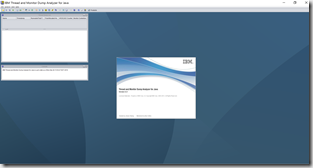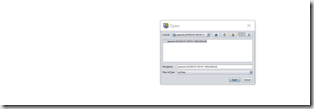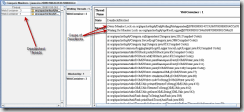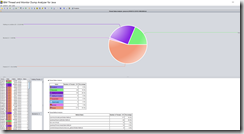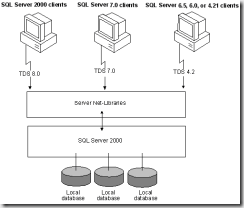In my previous blog posts I spent some time in illustrating tools for thread analysis for Oracle\Sun HotSpot JVM. However recently I actually had to analyze stack\javacore dumps from IBM WebSphere for hang condition and therefore had to research equivalent tools to analyze dumps from that JVM.
As we all know, during the run time of a Java process, some Java Virtual Machines (JVMs) may not respond predictably and oftentimes seem to hang up for a long time or until JVM shutdown occurs. It is not easy to determine the root cause of these sorts of problems.
By triggering a javacore when a Java process does not respond, it is possible to collect diagnostic information related to the JVM and a Java application captured at a particular point during execution. For example, the information can be about the operating system, the application environment, threads, native stack, locks, and memory. The exact contents are dependent on the platform on which the application is running.
On non IBM platforms, and in most cases, javacore is known as “javadump.” Check out my previous post of how to analyze dumps on Oracle Sun JVM via jstack utility. The code that creates javacore is part of the JVM. One can control it by using environment variables and run-time switches. By default, a javacore occurs when the JVM terminates unexpectedly. A javacore can also be triggered by sending specific signals to the JVM. Although javacore or javadump is present in Sun JVMs, much of the content of the javacore is added by IBM and, therefore, is present only in IBM JVMs.
This technology analyzes each thread information and provides diagnostic information, such as current thread information, the signal that caused the javacore, Java heap information (maximum Java heap size, initial Java heap size, garbage collector counter, allocation failure counter, free Java heap size, and allocated Java heap size), number of runnable threads, total number of threads, number of monitors locked, and deadlock information.
You can download tool from here – https://www.ibm.com/developerworks/community/groups/service/html/communityview?communityUuid=2245aa39-fa5c-4475-b891-14c205f7333c.
Once the tool is downloaded, you can run jca.jar with the Java Run-time Environment
This will open up the tool
Let’s now use File-Open and open a javacore\dump file
The tool will show a screen with a progress bar while it loads the javacore. Clicking on the javacore you just loaded in the Thread Dump List
As you can see you get huge amount of JVM settings details, as well as If the tool detected a deadlock then it will be displayed in the lower section of the Thread Dump List
and
Selecting the Compare Monitors option from Analysis Menu will show deadlocked threads
Another useful screen is Thread Status Screen. Here you can see RUNNABLE vs. PARKED vs. BLOCKED threads and associated stacks. This screen can be very useful in resolving slow response and hang conditions
A complete explanation of all thread states for Java 7 can be found here – https://www.ibm.com/support/knowledgecenter/SSYKE2_7.0.0/com.ibm.java.aix.71.doc/diag/tools/javadump_tags_threads.html. Once you locate the RUNNABLE threads that are executing your application code, find out which method is being executed by following the stack trace. You may get assistance from development team if needed. Also note the Thread ID.
The following Thread in the example below is in BLOCK state which typically means it is waiting to acquire a lock on an Object monitor. You will need to search in the earlier section and determine which Thread is holding the lock so you can pinpoint the root cause.
3XMTHREADINFO "[STUCK] ExecuteThread: '162' for queue: 'weblogic.kernel.Default (self-tuning)'" J9VMThread:0x000000013ACF0800, j9thread_t:0x000000013AC88B20, java/lang/Thread:0x070000001F945798, state:B, prio=1 3XMTHREADINFO1 (native thread ID:0x1AD0F3, native priority:0x1, native policy:UNKNOWN) 3XMTHREADINFO3 Java callstack: 4XESTACKTRACE at org/springframework/jms/connection/SingleConnectionFactory.createConnection(SingleConnectionFactory.java:207(Compiled Code)) 4XESTACKTRACE at org/springframework/jms/connection/SingleConnectionFactory.createQueueConnection(SingleConnectionFactory.java:222(Compiled Code)) 4XESTACKTRACE at org/springframework/jms/core/JmsTemplate102.createConnection(JmsTemplate102.java:169(Compiled Code)) 4XESTACKTRACE at org/springframework/jms/core/JmsTemplate.execute(JmsTemplate.java:418(Compiled Code)) 4XESTACKTRACE at org/springframework/jms/core/JmsTemplate.send(JmsTemplate.java:475(Compiled Code)) 4XESTACKTRACE at org/springframework/jms/core/JmsTemplate.send(JmsTemplate.java:467(Compiled Code)) …………………………………………………………………………………………………………
Hope this helps. For more see – https://www.ibm.com/developerworks/community/groups/service/html/communityview?communityUuid=2245aa39-fa5c-4475-b891-14c205f7333c, https://www.ibm.com/developerworks/community/blogs/e8206aad-10e2-4c49-b00c-fee572815374/entry/Java_Core_Debugging_using_IBM_Thread_and_Monitor_Dump_Analyzer_for_Java?lang=en
